【Vue笔记】-- 详解vue生命周期
针对于Vue的生命周期进行详细的说明,方面加深对各个方法的引用。
引言:
正文:

<!DOCTYPE html> <html lang="en"> <head> <meta charset="UTF-8"> <meta name="viewport" content="width=device-width, initial-scale=1.0"> <meta http-equiv="X-UA-Compatible" content="ie=edge"> <title>vue生命周期</title> <script src="https://cdn.bootcss.com/vue/2.4.2/vue.js"></script> </head> <body> <div id="app"> <h1>{{message}}</h1> </div> </body> <script> var vm = new Vue({ el: '#app', data: { message: 'Vue' }, beforeCreate: function() { console.group('------beforeCreate创建前状态------'); console.log(this.$el); console.log(this.$data); console.log(this.message) }, created: function() { console.group('------created创建完毕状态------'); console.log(this.$el); console.log(this.$data); console.log(this.message); }, beforeMount: function() { console.group('------beforeMount挂载前状态------'); console.log(this.$el); console.log(this.$data); console.log(this.message); }, mounted: function() { console.group('------mounted 挂载结束状态------'); console.log(this.$el); console.log(this.$data); console.log(this.message); }, beforeUpdate: function () { console.group('beforeUpdate 更新前状态===============》'); console.log(this.$el); console.log(this.$data); console.log(this.message); }, updated: function () { console.group('updated 更新完成状态===============》'); console.log(this.$el); console.log(this.$data); console.log(this.message); }, beforeDestroy: function () { console.group('beforeDestroy 销毁前状态===============》'); console.log(this.$el); console.log(this.$data); console.log(this.message); }, destroyed: function () { console.group('destroyed 销毁完成状态===============》'); console.log(this.$el); console.log(this.$data); console.log(this.message) } }) </script> </html>
结果显示如下:

ps:因为没有更新数据和销毁数据,所以beforeUpdate,updated,beforeDestroy和destroyed等钩子函数没有触发,只打印出beforeCreate,created,beforeMount和mounted的钩子函数情况。
在vue生命周期图例中可知,可以分为以下几个步骤:
一 beforeCreate—created间的生命周期


二 created—beforeMount间的生命周期


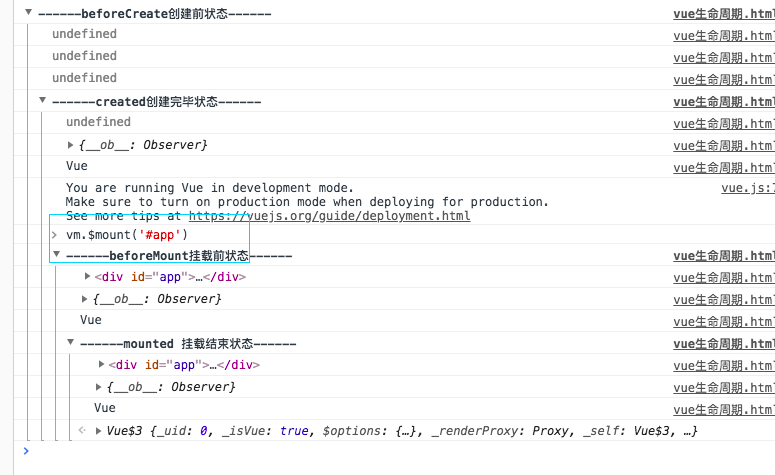
var vm = new Vue({ el: '#app', template:'<h1 style="color:red">{{message}}</h1>', data: { message: 'Vue' } })

2 当无template时:
<body> <div id="app"> <h1>{{message}}</h1> </div> </body>

3 当两者存在时,会优先选择template渲染函数。
<body> <div id="app"> <h1>{{message}}</h1> </div> </body> <script> var vm = new Vue({ el: '#app', template:'<h1 style="color:red">{{message}}</h1>', data: { message: 'Vue' } }) </script>

4 两者不存在时,则不渲染也不报错。
<body> <div id="app"> <h1>{{message}}</h1> </div> </body> <script> var vm = new Vue({ el: '#app', template:'<h1 style="color:red">{{message}}</h1>', render: function (createElement, context) { return createElement('h1',`${this.message}1111`) }, data: { message: 'Vue' }, }) </script>

三 beforeMount—mounted钩子函数的生命周期
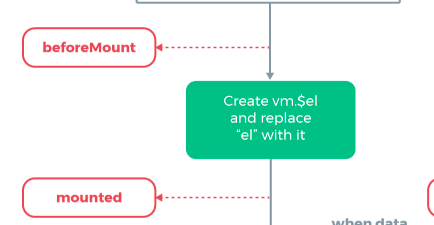
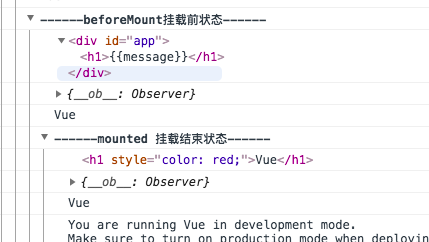
通过打印结果可知:
四 beforeUpdate—updated间的生命周期
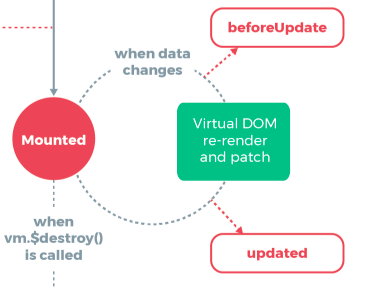
这一步是当vue的data数据发生改变,就会触发对应组件的重新渲染。然后依次触发beforeUpdate和update钩子函数。
<body> <div id="app"> <!-- <h1>{{message}}</h1> --> </div> </body> <script> var vm = new Vue({ el: '#app', // template:'<h1 style="color:red">{{message}}</h1>', data: { message: 'Vue' }, beforeUpdate: function () { console.group('beforeUpdate 更新前状态===============》'); console.log(this.$el); console.log(this.$data); console.log(this.message); }, updated: function () { console.group('updated 更新完成状态===============》'); console.log(this.$el); console.log(this.$data); console.log(this.message); }, }) vm.message = 'aaaa'; </script>
结果可知:没有触发钩子函数。

当把template的注释去掉,结果如下:触发了更新前后的钩子函数。
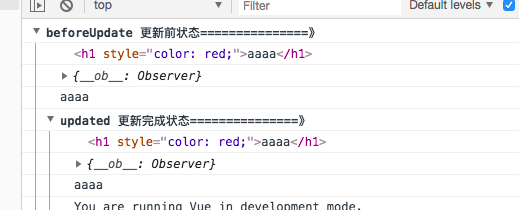
五 beforeDestroy—destroyed间的生命周期

var vm = new Vue({ el: '#app', template:'<h1 style="color:red">{{message}}</h1>', data: { message: 'Vue' }, beforeDestroy: function () { console.group('beforeDestroy 销毁前状态===============》'); console.log(this.$el); console.log(this.$data); console.log(this.message); }, destroyed: function () { console.group('destroyed 销毁完成状态===============》'); console.log(this.$el); console.log(this.$data); console.log(this.message) } }) vm.$destroy(); vm.message='11111' </script>
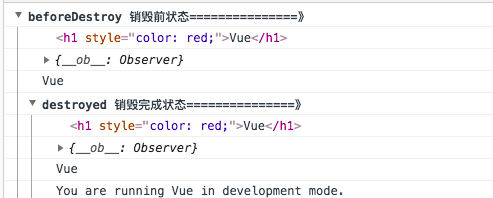
ps:因为只有$destroy()方法,所以没法判断beforeDestroy和destroyed的区别
结果如下:发现销毁之后,再重新给message赋值,没效果。可见destroyed钩子函数在$destroy()方法实行后会销毁和当前实例有关的东西,不会再次对该实例进行操作。
结尾:
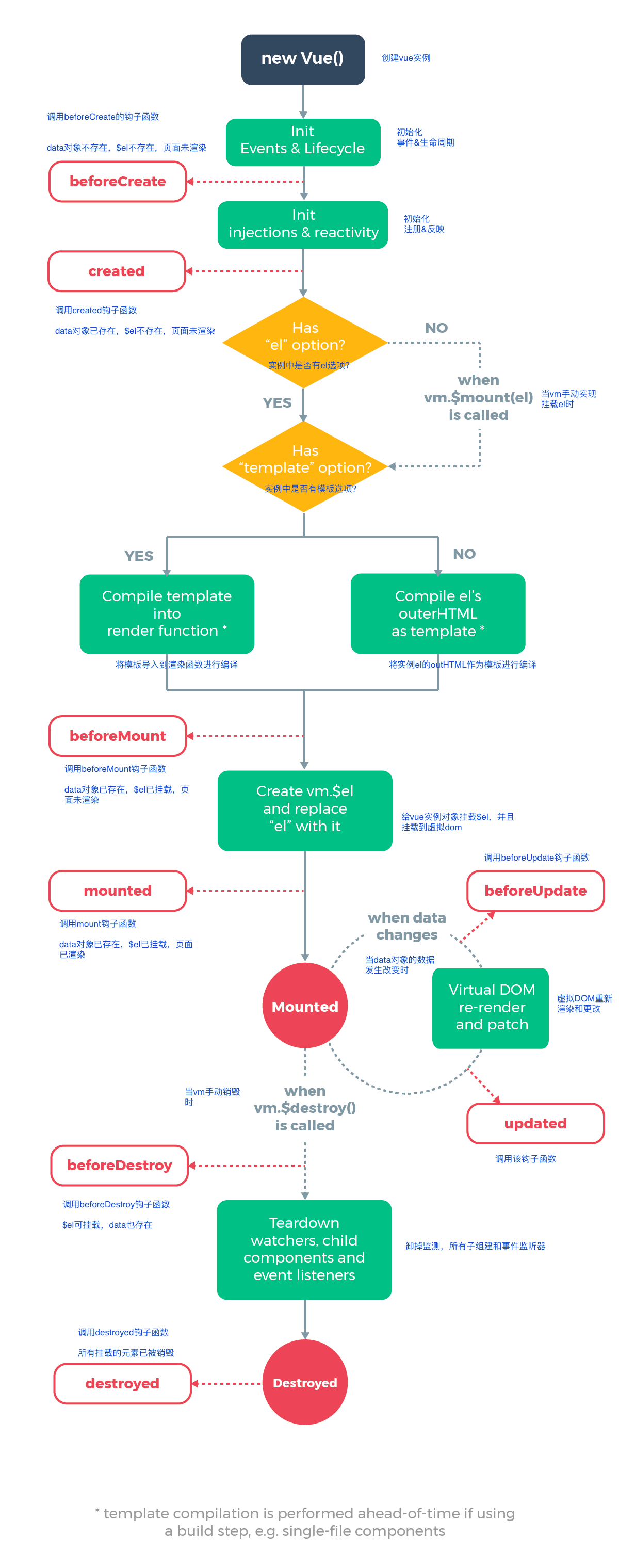
以上都是自己对vue的生命周期的理解,从一开始懵懂,到依次开发vue项目,回头再看这生命周期,就有一种“原来如此”的感觉,感到vue强大之处。
我是17号小白,我把完整代码放到gitHub里了,有需要实践的请前往clone。地址:https://github.com/sqh17/notes/blob/master/ways/vueLifecycle.html。
以上若有不对的地方,请大家能及时私信我或者下方评论,我们一起加油进步。
参考文献:




